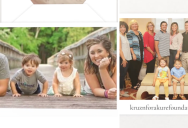Parents Raise $3M To Save Children With Fatal Form Of Dwarfism
by Trisha Leigh

No one decides to have children thinking that, three years and two children in, they’ll learn that not one, but both kids have a fatal genetic mutation without a cure.
That’s what happened to Jessica and Kyle Davenport, though, whose 3yo son Kruz and 1.5yo daughter, Paizlee, were both diagnosed with Schimke immuno-osseous dysplasia (SIOD). which is a rare and fatal form of dwarfism.

Image Credit: YouTube
The condition causes kidney failure, a weakened immune system, skeletal dysplasia, migraines, and a high risk of stroke and seizures.
SIOD only affects about a dozen people in the United States, and Kruz and Paizlee are the first known sibling pair diagnosed with the condition.
“There was a one-in-80-million chance that she would have it. And then she tested positive. All I could think about was, ‘I cannot lose both of my kids.'”

Image Credit: YouTube
With so few people battling the disease, and the life expectancy being less than a decade, the funding for research as far as a cure was pretty much nonexistent – at least it was until Jessica and Kyle stepped up to the plate.
In 2016 they started selling $5 bracelets and T-shirts, managing to raise $100,000 in just a few months.
They expanded their efforts, launching Kruzn for a Kure and, even with an average donation of $25, raised over $3 million.

Image Credit: YouTube
Jessica has quit her job to be a full time mom and philanthropist and says “we’d do anything for our kids.”
They thought they would lose their son in 2017, when his kidney failed, but their foundation came through with over $30,000 a day to partner with immunologist and leading SIOD expert Dr. David Lewis instead.
Dr. Lewis saved the children’s lives with a pioneering kidney transplant procedure called a dual immune/solid organ transplant (DISOT).
He and his team at Stanford Medicine Children’s Health were impressed with Jessica’s efforts, especially.
“It’s hard to get funding for rare diseases, but I’ve never met anyone more capable than Jessica.

Image Credit: YouTube
After receiving the transplants and subsequent stem cell transplants to ensure their immune systems would be able to handle it, they returned home to Alabama.
“This was the first time [DISOT] had been done anywhere in the world. It doesn’t cure all the problems of SIOD, but it’s a cure for the blood, the immune system and the kidneys.”

Image Credit: YouTube
The kids are going to school, playing with friends and are doing regular things like going bowling for the first time.
Although their situations are much improved after the transplants, they do face daily challenges associated with their condition.
For Kruz, that looks like hip dysplasia, hemiplegic migraines, and temporary paralysis of the arms and face.
The Davenports aren’t resting on their laurels, though, and are continuing to partner with Stanford to come up with promising drug therapies and more cutting-edge procedures.
“When Kruz was first diagnosed, it was agonizing. We had no one, and no hope for our kids besides our faith. As a mother, I want to make sure these families who are newly diagnosed have somewhere to turn, so they can go to sleep at night and know that there’s hope.”
Sometimes that’s all you need to keep going through the hard times.
Categories: STORIES
Tags: · dwarfism, science, single topic, top

Sign up to get our BEST stories of the week straight to your inbox.




